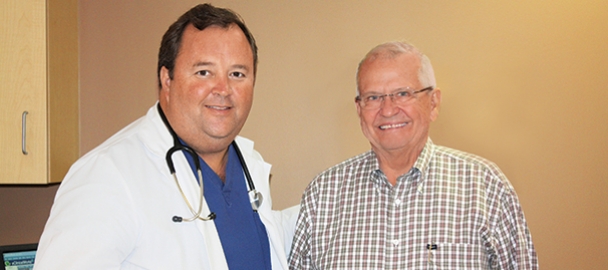
John Hundley had reason to celebrate. His multiple myeloma, a cancer that affects the plasma cells in bone marrow, was in complete remission. And at age 68, semi-retirement afforded him time to pursue both his business interests and passion for gourmet cooking. But one warm evening, the Ladera Ranch resident’s life took another turn.
A Cardiac Emergency
“I suddenly felt extremely ill,” he says. I was weak, nauseous and sweating profusely.” Alarmed, his wife drove him to the emergency department at Saddleback Memorial Medical Center in San Clemente. Tests confirmed he had suffered a major heart attack—the result of a blockage in one of the arteries that supply the heart with blood.
John was immediately transferred to Saddleback Memorial-Laguna Hills. The hospital is designated by Orange County Emergency Medical Services as a cardiac receiving center. Equipped with a state-of-the-art cardiovascular catheterization lab, the hospital’s cardiac receiving center is one of the few in Orange County with treatment times better than the national average.
Even before John arrived, interventional cardiologist Michael Gault, M.D., and the cardiac catheterization team were mobilized to perform balloon angioplasty—a catheter-based procedure that opens blocked blood vessels without surgery. Dr. Gault says that timing is critical.
When Minutes Matter
“With each minute that passes after a heart attack, more heart tissue is damaged or dies. For the best outcomes, angioplasty should be performed within 90 minutes of the time a patient enters the emergency room.”
Dr. Gault opened the blocked artery using a balloon-tipped catheter inserted through a small incision in John’s groin. A stent—a small mesh tube—was placed inside the artery to help it stay open. John did well after the lifesaving procedure. But a few months later, another blockage required a second balloon angioplasty to clear the artery.
Another Crisis Prevented
In December 2010, John faced a third crisis when his heart suddenly stopped beating. Known as sudden cardiac arrest, this occurs when a disturbance in the heart’s electrical system causes an abnormally fast heart beat. If not treated within minutes, sudden cardiac arrest is fatal. Fortunately, paramedics were able to restart John’s heart, and a few days later, an implantable cardioverter defibrillator (ICD) was placed in his chest. This device—small enough to fit in the palm of the hand—prompts the heart to beat at a normal rate.
John improved steadily after receiving the ICD. Today his heart is functioning normally. In the fall of 2011, he and his wife of 44 years spent three weeks touring—and sampling the cuisine—in Italy, Switzerland and France. “I owe everything to Dr. Gault and the amazing staff at Saddleback Memorial,” he says. “I have absolute confidence in their skill and expertise, and the level of care I received was extraordinary. If I hadn’t gotten to the hospital quickly, things might have turned out differently.”
Dr. Gault stresses that timing is everything when it comes to a heart attack. “Anyone who has heart attack symptoms should call 9-1-1 immediately,” he says. “Even a minute’s delay is too long.”